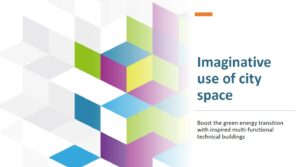Maëlle Caussarieu & Kirsten Dyhr – Mikkelsen
What was your inspiration to come up with the ATELIER student competition?
There were three main reasons – 1) A need for multi-functional technical buildings, 2) a wish to learn from other countries and professions, and 3) to help foster a new generation of architects/citizens that understands the demands of the energy transition from a city planning perspective. Space is a limited resource in our cities. We are currently preparing our next climate strategy and it is clear that more local energy production is needed. A few districts reaching energy positivity is not enough to fulfill our climate ambitions. We need to find a way to make replication easier and to engage the city population in the endeavor. Space is a very limited resource in our cities, so we must build smart. We were therefore looking to gather inspirational ideas for combining technical buildings with other city functions and compile these into a catalogue that can inspire and guide the design of energy positive districts in any city. Ensuring a high aesthetic quality of the build and its surroundings, could even make the buildings proud landmarks – signaling district identity instead of simply trying to hide or camouflage the technical buildings.
We wanted an international competition since each nation has its unique way of living and using city space. Our hope was that this could perhaps inspire us to a new city culture and infrastructure that is more sustainable. Mutual exchange of ideas, expertise and lessons learned is in our opinion key to a successful energy transition. That is also why we engage in projects such as ATELIER. And finally, we wish to encourage students and young professional to work towards sustainability by providing them real-life challenges to practice their skills. Students have the added quality that they are free to challenge our beliefs more radically than a professional consultant.
What was the biggest challenge in organizing and managing the student competition?
The biggest challenge was to align the timing with school timelines, especially when you are seeking contestant from several schools and across borders. The recommendation from experienced people within architecture was that architect students are used to participating in competition that require them to use their spare time outside the study. Looking back, I think that integrating the competition in the school curriculum might be a better suited approach – and perhaps even have a bigger impact on the student learning.
What were the most important criteria in order to be among the three winning teams?
The listed competition criteria, hopefully, reflect our wish to think out of the box and at the same time be realistic about what can be achieved. We were looking for a concept with a clear identity that can be applied in many different locations in our own city but also other cities. A concept with a clear architectural identity that can easily be modified depending on the location and budgets, and still retain its identity. Another quality that the winning concepts possess is that they encourage the public to engage in the energy transition and sustainability – by providing a glimpse into the heat pump technology or by expanding the idea of multi-functionality to making the build a hub for sustainability activities for the society. Another consideration was the use of resources in the build and to which extent the original concept Is likely to be diluted in the construction process a.o. due to economic realities.
How could you as a jury benefit from this experience?
It is always inspiring to see what solutions young people, not yet set in their way of thinking and not bound by the experience and constraints that we operate under, can come up with.
Did the submitted concepts provide inspiration for future challenges in Copenhagen and Bratislava?
Yes definitely! We still need to find space for electricity transformer stations and if they in any way can be made more architecturally attractive and even multifunctional, our cityscape would benefit greatly. It has also been very inspiring to see the students’ different takes on the presented problem.
We originally intended to encourage teams composed of students from different types of studies – architecture, landscape, engineering, social studies etc. But the experiences from people that we talked to, who had tried such an approach, were that it requires enormous efforts from the organisers, the schools, and the students, and still the risk is that no true integration in the solution creation takes place. Also, such an approach would shift focus from the idea of a catalogue of concepts that can be applied in many variations and locations and not just tailored to one specific site.
Are there any lessons learned?
The architect schools appear very interested in this type of competition and some have expressed an interest in integrating it into their semester work. Doing so would give the students better time to reflect and do the necessary work and could be combined with thematic guest lectures relating to the transition challenge that our cities are facing.
Awards in the form of cash prizes are difficult for a municipality to apply – a private sponsor is needed.
It is not a simple task to really hone out what the competition task should be. We drew on the expertise of architects, technology experts, city planners, educators, and competition organisers to arrive at a suitably focused and manageable competition task and format.

